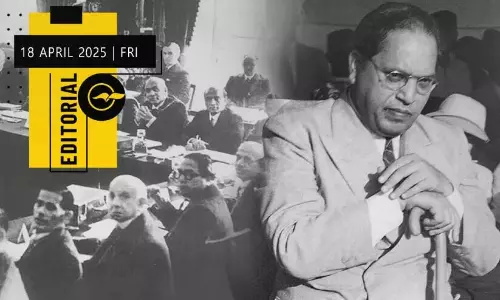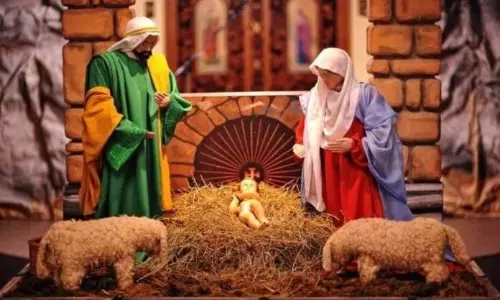

Monson Mavunkal
Monson: A prophet for our fake news times
text_fieldsThe Monson Mavunkal episode has the characteristic flavour of a classic tale in its universality and timelessness. To each of us, the frame of the Monson story is familiar: a smart chap feigning as a learned man fooling people belonging to a self-proclaimed 'intellectual' society. He fabricated artefacts that he said belonged to antiquity at a local workshop and made the cream of Kerala believe that they were for real. At the very outset, let us appreciate that Mavunkal scammed only the society's elites and not the common folk.
Now we know this clever fellow swindled Rs 10 crores from different people from 2007 till the start of the 2020 Covid season, citing the expected revenues from his antique trade; the articles of which he had got sculpted from a local workshop. His victims have now found him with just Rs 200 left in his bank account. Mavunkal is remanded to judicial custody till October 9.
In Kerala, where Jesus' disciple St Thomas is believed to have arrived in AD 52, it was perhaps possible to pull off a trickery claiming that 2000-year-old coins, from among Judas' remuneration of 30 silver coins for betraying Jesus, figure in Mavunkal's collections.
It is another matter that no believer would want to keep the two coins that put his/her Saviour on the Cross (there is indeed a Malayalam phrase to describe people of the basest kind that "he or she possesses the coins earned by selling Jesus"). Neither would a true historian have bought such a tall story from a start-up artefact collector, with no domain questions asked pertaining to the historic dating of the article.
What about Moses' Staff from the Old Testament times? Whether Old Testament is part of history or mythology, the Staff didn't look as if it had stood the ravages of centuries in the desert sand. Such questions pertain to each item in the Mavunkal collection.
Apart from Judas' coins and Moses' Staff, it also includes the miraculous stone jug in which Jesus converted water into wine at a marriage in Cana; Chattrapathi Shivaji's private copy of the Bhagvad Gita; coronation ring of Aurangazeb; Sree Narayana Guru's walking stick; a sacred sculpture of Nandi; the registration document of Mysore Palace; Sathya Sai Baba's golden footwear; the throne of the Maharajah of Travancore; paintings by Raja Ravi Varma and Leonardo da Vinci; a Picasso painting done in gold; a clay lamp and prayer mat used by Prophet Mohammed; copies of Quran in the gold used by Akbar, Shajahan and Aurangazeb; St Alphonsa's habit, a palm leaf manuscript of Quran quotes, all perhaps aimed at exploiting the burgeoning penchant for artefact collection seen among Malayalis spread across the globe.
With his artefacts straddling with wanton abandon different eras of Christian, Muslim and Hindu history, mythology and religion, modern art and Kerala social reforms, etc., Monson has shown that he is immaculately 'secular', cheating Kerala's gullible elite from all castes and creeds.
And Monson's Malayalis present themselves as a perfect foil of gullible simpletons who lent him huge credit on the wings of his ostentatious lifestyle. All this, despite the Malayali self-image of being the most rational people on the subcontinent.
Italo Calvino says in his 'Why Read the Classics?' that most adults only "re-read" the classics. The storyline in classics is already imprinted somewhere in every reader's consciousness from several references and retellings of the same from childhood. Yet each new rereading of the prototype retains a certain sense of discovery. The full text of the Mavunkal classic is still unfolding in Kerala. The story of deceptions and money swindling, supposed to have started as far back as in 2007, fell out of the bag last week. Within a week, the photographs of a clutch of film stars, politicians and influential police officers who sat on "Tipu Sultan's throne" was out.
However, the sins of Monson Mavunkal, the 52-year old native of Kerala from Cherthala, should be expiated as his case offers the much needed comic denouement to the high strung atmosphere of communal tension that prevailed in the state, unleashed a month ago by Bishop Kallarangatt's narcotics jihad slur. Some months before in time to influence elections, the BJP had raked up the issue of women's entry to Sabarimala, with the Congress too chipping in. Mavunkal's scam is a wake-up call for fresh re-examinations of Malayalees' overrated self-assumptions of rationality. The joke is clearly on Kerala society for having lost our native wit and refusing to ask fundamental, pertinent questions in a timely manner. If we lose our self-critical edge, we will be duped by our own self-delusions. The perfect scamster appears on the scene when blind faith and never-ending fantasies of religious and cultural custodianship become a readily saleable commodity in society. In this decade of fake news, Monson can be seen as a prophet in disguise, can be hoisted as a veritable brand ambassador of secular Kerala.
(Leena Mariam Koshy is an independent writer based in Kozhikode, Kerala.)






















